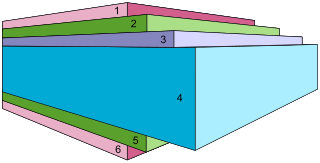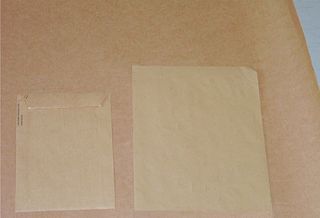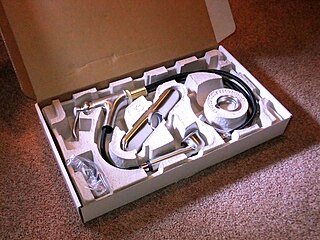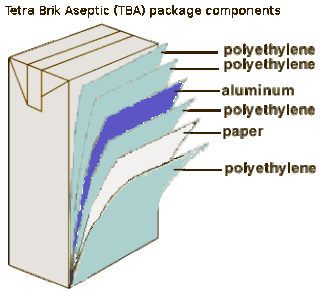
1 – Coating
2 – Solid Unbleached Board
Not drawn to scale
Solid unbleached board, also known as SUB, is a grade of paperboard typically made of unbleached chemical pulp. Most often it comes with two to three layers of mineral or synthetic pigment coating on the top and one layer on the reverse side. Recycled fibres are sometimes used to replace the unbleached chemical pulp. [1]

Paperboard is a thick paper-based material. While there is no rigid differentiation between paper and paperboard, paperboard is generally thicker than paper and has certain superior attributes such as foldability and rigidity. According to ISO standards, paperboard is a paper with a grammage above 250 g/m2, but there are exceptions. Paperboard can be single- or multi-ply.
Coated paper is paper which has been coated by a mixture of materials or a polymer to impart certain qualities to the paper, including weight, surface gloss, smoothness or reduced ink absorbency. Various materials, including Kaolinite, calcium carbonate, Bentonite, and talc can be used to coat paper for high quality printing used in packaging industry and in magazines. The chalk or china clay is bound to the paper with synthetic viscosifiers, such as styrene-butadiene latexes and natural organic binders such as starch. The coating formulation may also contain chemical additives as dispersants, resins, or polyethylene to give water resistance and wet strength to the paper, or to protect against ultraviolet radiation.
The main end use for this type of board is for packaging of frozen or chilled food, beverage carriers, detergent [2] cereals, shoes, toys and others. [3]

Freezing food preserves it from the time it is prepared to the time it is eaten. Since early times, farmers, fishermen, and trappers have preserved grains and produce in unheated buildings during the winter season. Freezing food slows down decomposition by turning residual moisture into ice, inhibiting the growth of most bacterial species. In the food commodity industry, there are two processes: mechanical and cryogenic. The freezing kinetics is important to preserve the food quality and texture. Quicker freezing generates smaller ice crystals and maintains cellular structure. Cryogenic freezing is the quickest freezing technology available due to the ultra low liquid nitrogen temperature −196 °C (−320 °F).
Chilled food is food that is stored at refrigeration temperatures, which are at or below 0 – −5 °C (32–23 °F). The key requirements for chilled food products are good quality and microbiological safety at the point of consumption. They have been available in the United Kingdom, United States, and many other industrialized countries since the 1960s.

A detergent is a surfactant or a mixture of surfactants with cleaning properties in dilute solutions. These substances are usually alkylbenzenesulfonates, a family of compounds that are similar to soap but are more soluble in hard water, because the polar sulfonate is less likely than the polar carboxylate to bind to calcium and other ions found in hard water.











